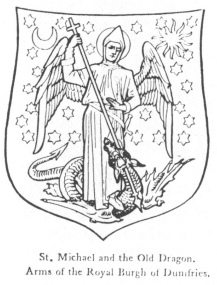Today is Michaelmas (the feast of Michael and the Holy Angels). It's pronounced "MICK-el-mus" and is a traditional starting time for school. In God's providence, it also falls immediately after Yom Kippur this year.
Collect: Everlasting God, who have ordained and constituted in a wonderful Order the ministries of angels and mortals: Mercifully grant that, as your holy angels always serve and worship you in heaven, so by your appointment they may help and defend us here on earth; through Jesus Christ our Lord, who lives and reigns with you and the Holy Spirit, one God, for ever and ever.
Readings: Psalm 103; Genesis 28:10-17; Revelation 12:7-12; John 1:47-51
 | Cathedral Choral Society, Washington National Cathedral - Ye watchers and ye holy ones 17c |  |
 | ||
 | Found at bee mp3 search engine |  |
bright seraphs, cherubim, and thrones,
raise the glad strain,
Alleluia!
Cry out, dominions, princedoms, powers,
virtues, archangels, angels' choirs,
Refrain:
Alleluia! alleluia! alleluia!
Alleluia! alleluia!
O higher than the cherubim,
more glorious than the seraphim,
lead their praises,
Alleluia!
Thou bearer of the eternal Word,
most gracious, magnify the Lord, Refrain
Respond, ye souls in endless rest,
ye patriarchs and prophets blest,
Alleluia,
alleluia!
Ye holy twelve, ye martyrs strong,
all saints triumphant, raise the song, Refrain
O friends, in gladness let us sing,
supernal anthems echoing,
Alleluia,
alleluia!
To God the Father, God the Son,
and God the Spirit, Three in One, Refrain
 In the days before widespread literacy, the Church taught with images. Cultural commentators tell us that images are making a come-back (TV, YouTube, etc.) as the power of the written word seems to diminish among the hoi polloi. While this is to be lamented, all is not lost. Again - the Church taught the faith this way for over a millenium.
In the days before widespread literacy, the Church taught with images. Cultural commentators tell us that images are making a come-back (TV, YouTube, etc.) as the power of the written word seems to diminish among the hoi polloi. While this is to be lamented, all is not lost. Again - the Church taught the faith this way for over a millenium.Today, as I reflect on the Feast of St. Michael and All Angels, I'm struck by what the iconography teaches about our spiritual warfare. Look at these pictures and tell me what you notice.


Seeing a common theme, yet?

 Try noticing where the spear is placed.
Try noticing where the spear is placed.Do you see it?
ALWAYS AT THE MOUTH.
(The same is true in the iconography of St. George, Patron protector of England, whose shield has been adopted as the symbol for the Anglican Church in North America.)
 Why?
Why?Because Satan's greatest tool is deception!
Our spiritual warfare consists of being sanctified in the truth and casting down arguments that hold themselves up against the truth of Christ. It's not easy - and in an age that appreciates the appearance of substance rather than substance itself - it can get you labeled as "mean" or "intolerant" or "narrow-minded."
But remember that the highest messenger of God (literal translation of archangel) is so because he constantly destroys the lies of the devil, robbing him of power in the world.
Go and do likewise.
(Here's some help.)
Holy Michael, the Archangel, defend us in battle. Be our safeguard against the wickedness and snares of the devil. May God rebuke him, we humbly pray; and do you, O Prince of the heavenly host, by the power of God cast into hell Satan and all the evil spirits who wander through the world seeking the ruin of souls. Amen.
The Prayer of Leo XIII
to be said after Mass
to be said after Mass






6 comments:
"In the days before widespread literacy, the Church taught with images."
Actually, they preached the Scriptures. It wasn't until several hundred years after the Apostles that the idolatry of iconography invaded the church.
Kevin,
Of course we taught with sermons. But there were also memorable images made that conveyed heavenly truths - just as had been done under the old covenant. Not images to be worshiped, but rather that elevated the mind and taught.
Would you consider yourself an iconoclast (in the literal, historical term)? If so, what do you think of the Docetism that fueled iconoclasm? And do you allow flannelgraphs to be used in teaching your pre-literate?
"But there were also memorable images made that conveyed heavenly truths"
Do you actually have any historical evidence for that? I'll wait. For a really long time. The truth is, there was no iconography in the church during the first two centuries AD.
As far are the distinction you make (a al John of Damascus) between worship and veneration, that is a mighty fine hair to split given the Second Commandment.
Yes the Tabernacle/Temple employed figures of angels, but the major difference is that those things were expressly commanded by God to be made. Other images were expressly forbidden.
Calvin's Institute's 1.xi is a good read on this subject. He demolishes every argument you could possibly think of to support icons in a fairly straightforward manner.
In any event, why would we pray to an angel? God is the subject of our prayers and no one else.
To answer your quesion, no, we do not use images of Christ at all. I refer you to the Second Commandment again.
How about something from Clement of Alexandria (153-217 AD) who wrote in Paedogogus 3:11.
"And let our seals be either a dove, or a fish, or a ship scudding before the wind, or a musical lyre, which Polycrates used, or a ship's anchor, which Seleucus got engraved as a device; and if there be one fishing, he will remember the apostle, and the children drawn out of the water."
The catacombs are chock-full of paintings of OT stories, NT Stories, and heavenly scenes.
I've read Calvin on this subject. I've also read the early Church Fathers on it. Calvin is railing against images of God - which we do not make presume to make. He is not at his strongest in arguing against images as books of the unlearned - he relies on ipse dixit and pish posh! statements, trots out a few bad examples of pre-Rococo excess, and declares victory. If that's enough to overturn 1300+ years of practice, then the women's ordination folks will have an easy time of things.
As for prayers to Angels, I prolly shouldn't have included that. It's not part of my piety - but it is a historic practice that was put in place for strength in the struggle against modernism.
I'll look up those references. BTW, I believe the problem with the iconoclasts was Nestorianism, not Docetism.
Right you are! I should have checked it before I spouted off.
Post a Comment